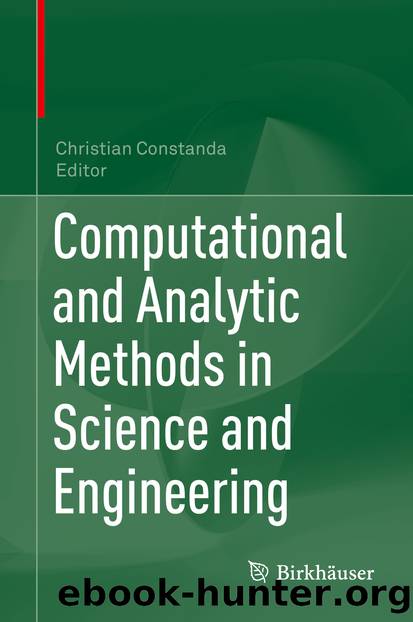Computational and Analytic Methods in Science and Engineering by Unknown

Author:Unknown
Language: eng
Format: epub
ISBN: 9783030481865
Publisher: Springer International Publishing
As is well known, from the mechanical viewpoint, the small regions behave as “springs” and the elastic coefficients of these springs are defined through the so-called Robin reaction matrix, which we denote by β(ε)M(x). Matrix M(x) depends on the point where the reaction regions T ε are placed, while the parameter β(ε), which is referred to as the reaction parameter, can range from very small to very large. The reaction regions T ε are assumed to be domains of the plane homothetics of a fixed domain T, with a Lipschitz boundary. Analyzing the different relations between the three parameters of the problem, ε, r ε and β(ε), is crucial to detect several behaviors of the vibrations of the structure. We consider the associated spectral problem and we address the asymptotic behavior of the eigenvalues and eigenfunctions when ε → 0. Namely, we obtain spectral homogenized problems depending on the relations between ε, r ε and β(ε).
The stationary problem, for an isotropic homogeneous media, cf. (7.54), and a surface Σ which is stuck to the plane along the regions T ε, has been studied in [LoPe87, LoPe88] and [BrEtAl90], where a critical size O(ε 2) of the stuck regions appears (cf. (7.1) with r 0 > 0), which is somehow classical in the literature of the applied mathematics. For this size, the asymptotic behavior of the solution is intermediate between the extreme cases. Namely, for r ε ≫ ε 2 the stuck regions are large enough and the body behaves as if the whole Σ is stuck to the plane; for r ε ≪ ε 2 the stuck regions are very small and the surface behaves as if it would be free, while for r ε = O(ε 2) a spring/Robin boundary condition is asymptotically imposed as an intermediate condition between Dirichlet and Neumann. It contains the so-called strange term and links stresses and displacements, the elastic coefficients of this spring being given by a constant matrix, the so-called capacity matrix (cf. (7.20) and (7.21) for W l, x ≡ W l independent of x).
Here, we deal with a different problem, and obtain the above-mentioned homogenized problems for a particular relation between the parameters. As a matter of fact, in addition to the critical size, a critical relation for parameters appears (cf. (7.3) with β ∗ > 0) which also provides the asymptotic behavior of solutions different from extreme cases. Now, several kinds of capacity matrices arise, which are obtained from the microstructure of the problem and depend on the macroscopic variable. This dependence is due to both the nonhomogeneous media Ω and the non-constant Robin matrix M(x).
Notice that other different boundary homogenization problems in linear elasticity have been addressed in the literature. Let us mention [NgSa85] and [GrMiOr15], which consider stationary homogenization problems for the elasticity system in a perforated media along a plane, the size r ε of the perforations in the plane being r ε = O(ε). Also, [BrLoPe90, LoPe92] and [JaAdBr00] consider cylindrical bodies, the regions where the displacements vanish being thin bands rolled around the body; a different critical size and capacity matrix appear on account of the geometrical configuration of the domain.
Download
This site does not store any files on its server. We only index and link to content provided by other sites. Please contact the content providers to delete copyright contents if any and email us, we'll remove relevant links or contents immediately.
Kathy Andrews Collection by Kathy Andrews(11270)
The remains of the day by Kazuo Ishiguro(8338)
Paper Towns by Green John(4750)
Spare by Prince Harry The Duke of Sussex(4745)
The Body: A Guide for Occupants by Bill Bryson(4534)
Industrial Automation from Scratch: A hands-on guide to using sensors, actuators, PLCs, HMIs, and SCADA to automate industrial processes by Olushola Akande(4405)
Be in a Treehouse by Pete Nelson(3620)
Harry Potter and the Goblet Of Fire by J.K. Rowling(3576)
Never by Ken Follett(3477)
Machine Learning at Scale with H2O by Gregory Keys | David Whiting(3413)
Goodbye Paradise(3412)
The Remains of the Day by Kazuo Ishiguro(3099)
Into Thin Air by Jon Krakauer(3097)
The Cellar by Natasha Preston(3058)
The Genius of Japanese Carpentry by Azby Brown(3009)
Drawing Shortcuts: Developing Quick Drawing Skills Using Today's Technology by Leggitt Jim(2910)
120 Days of Sodom by Marquis de Sade(2904)
Fairy Tale by Stephen King(2846)
The Man Who Died Twice by Richard Osman(2773)
